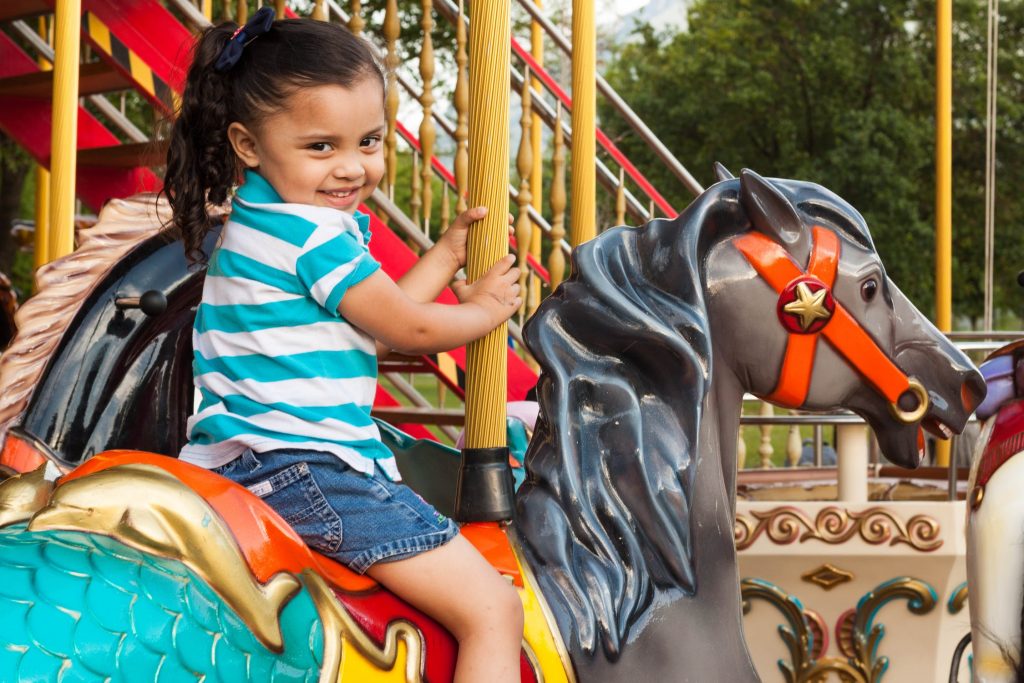When it comes to school fairs, effective planning and organisation is essential to creating an event that is both safe and enjoyable.
And while health and safety shouldn’t be a barrier to holding school events, it’s important to make sure that risks to staff and visitors have been assessed and adequately controlled.

Depending on the scale of the event and the activities on offer, it may be that a series of basic steps is all that’s required; however, taking the time to ensure risk is minimised is crucial to preventing accidents, injury and regulatory involvement.
In this article, we summarise the measures schools should take ahead of time, plus some of the key questions organisers will need to think about.
The precise health and safety arrangements will depend on the size and nature of your fair. Individual circumstances need to be considered in order to identify the risks relating to your specific event. However, the main principles remain the same.
Duty of care
As the event holder, your school has a duty of care to both the attendees and staff. It is important to address the following main points, preferably in a written document:
- That overall responsibility for the event is acknowledged; and
- The individuals or organisations who are in control of certain aspects of the fair are named, with their area of control clearly identified – an organisational chart may help.
Conducting a risk assessment
Your school will be responsible for identifying hazards and risks and ensuring everyone’s safety via a risk assessment.
The purpose of a risk assessment is to identify hazards that could cause harm. You then have to evaluate whether you have implemented enough precautions (‘control measures’) or whether more should be done to prevent harm. Hazards to consider include:
- Trip or equipment hazards. Could people trip over cables or guy ropes?
- Crowd management hazards. Could crushing/overcrowding occur?
- Crew hazards. How will you protect those working for you from lifting and carrying injuries?
- First aid hazards. Could people become injured through the fair’s activities?
- Weather hazards. Could the ground become slippery when wet?
- Fire hazards. How will you control smoking in the venue or onsite?
- Catering hazards. Could ovens or hot water urns cause a risk?
- Child protection hazards. Is there a risk of children becoming lost?
Write down all possible risks and who is at risk – be it attendees, crew, members of the public or the venue itself. Then write down how you will mitigate and manage each risk. This should not involve reams of paperwork – just note the basic measures to be taken.
Next, consider whether you can eliminate the hazard altogether. If not, you must control the risk. This will help to ensure your health and safety measures are adequate. A written risk assessment should be prepared so that everyone involved is aware of the measures being taken.
5-step approach to risk assessment
The risk assessment process can be broken down into five key steps:
- Identify the hazards and those at risk;
- Evaluate the risks and decide on control measures;
- Record your findings and make a plan of action;
- Implement any additional identified controls; and
- Review your risk assessment.
Remember, health and safety management is largely a matter of taking simple, sensible, common-sense precautions, so focus on risks that could cause real harm.
Realistically, questions you will need to ask are:
- What could potentially go wrong?
- How could accidents happen and who might be harmed?
- Are the risks of somebody being harmed by a hazard high or low?
- What effect could this have on those present? (In other words, how serious could the harm be?)
- What needs to be done to control the risks and make your school fair safer?
Access and capacity considerations
When planning the event, you will need to think about:
- How people will get to your school. Make sure your publicity gives details of parking and public transport.
- Whether you need to put up signs on the surrounding roads to make the fair easier to find.
- The layout of the fair to ensure people and vehicles can move about safely.
- The number of people attending.
- How to keep the venue free from slip and trip hazards.
- Whether your venue is accessible for people with disabilities. You should make sure publicity is clear about the level of access visitors can expect and check for obvious hazards such as slopes or steep changes in ground level.

Further questions to ask include:
- Can attendees be safely accommodated inside the venue? Is there room to circulate? Are there pinch points where overcrowding could occur?
- Is there sufficient access to the venue for pedestrians and vehicles?
- Are there enough emergency exits?
- Does the site have any existing hazards?
- Are ground conditions and topography suitable when positioning any temporary structures?
Free Download: Definitive Guide to General Risk Assessments
Identify risks and keep your business compliant in this free guide
Planning your school fair
Once you have confirmed the suitability of your school site as a venue, you will need to organise and plan the day in detail.
1. Start with a written profile of your fair, including all the activities that are to take place and the estimated audience size and demographics – children, the elderly and disabled all have different needs.
2. Draft a site plan indicating where the structures, facilities, entrances and exits will be.
3. Start an event diary. Shortly before the fair, run through the details. Questions to ask include:
-
- Where will everybody be on the day?
- Does everyone know their roles and responsibilities, including what to do if something goes wrong?
- How will equipment and volunteers get to the venue – and away again?
- Will you be able to take hired equipment directly to and from the fair, or will it need to be stored?
- How close to the fair site can organisers’ vehicles get? You may need to use a trolley or volunteers to help carry equipment closer to the site.
- Who is responsible for money on the day? If you might raise a large amount, consider arranging for someone to collect the money throughout the day.
- Will you have enough activities?
- Do you have enough time, materials and people for setting up and clearing away?
4. Plan the layout of the fair. Prepare a plan showing the layout, including the exit routes. Remember to consider spacing and layout of attractions – make sure the site is big enough for all the planned activities.
5. If you intend to provide car parking, you may need to arrange for designated marshals. Provide them with high vis vests so they can easily be seen. Vehicles need to be directed away from pedestrians where possible – consider a traffic management plan.

6. Draw up strict school site rules for stallholders/operators.
7. Consider whether you need to provide suitable safety barriers around attractions, displays and equipment. Exit routes must be clearly identified and kept clear of obstructions.
8. Review any previous experience you have of holding events. Contact other schools who have held similar events to learn from their experience.
9. Plan for any situations that require urgent action. This could be anything from a fire to bad weather. Your emergency plan should include:
- Raising the alarm – how will you communicate the emergency with staff and volunteers?
- Informing the public – do you have an adequate public address system?
- Onsite emergency response – are there fire extinguishers?
- Evacuation – how will you move people including the disabled away from immediate danger to a place of safety?
- Traffic management – how will emergency vehicles gain access to the site?
- Providing first aid – is there sufficient medical provision?
An individual or group should be in charge of health and safety management planning. Your risk assessment and event plan should be communicated with all those involved, including stallholders, operators of attractions and exhibitors – so they can consider the hazards, risks and precautions required for the whole event and for each individual attraction and activity.
Setting up
- Provide staff with relevant information during their induction to the fair. This should include information such as site hazards, speed limits and parking, first aid, toilets and wash facilities, and emergency arrangements.
- Storage and movement of goods and materials needs to be considered. Make arrangements for moving any heavy items. Do not take unnecessary risks when putting up large marquees, tents, etc. It is sensible to have a large marquee erected and taken down by the company it is hired from – marquees must only be erected by competent persons who are familiar with how it is done.
- Make sure any hired structures such as bouncy castles have an up-to-date inspection certificate and that they are properly tethered and used in accordance with manufacturer’s instructions and guidance. You should also arrange for the equipment to be supervised by one or more competent persons at all times – consider erecting signs indicating age or height restrictions applicable to the equipment.
- Gazebos, marquees and tents must similarly be weighted and/or staked to prevent movement in high winds.
- If hiring a fairground ride, check it has an up-to-date certificate of conformity – equivalent to a car’s MOT certificate.
- Check cables and wiring for electrical equipment, lighting and PA systems. Make sure all cables are laid safely away from public areas, or if this is not possible, cover and protect them. Make sure a competent person has installed and tested any electrical equipment.
- Monitor risks throughout your fair by creating a checklist and having a nominated monitoring person.
Accounting for the weather
Remember the British weather can be fickle – so think about:
- What impact heavy rain, strong winds or very hot weather could have;
- Providing shelter from heavy rain and/or strong sunlight; and
- Whether there is a risk the ground could become damp and slippery.
If using mains voltage outside, use a ‘trip device’ to ensure the current is promptly cut off if contact is made with any live part.
Overseeing stalls and attractions
Stalls and tables should be in good condition and erected on firm ground. Make sure they can support the weights placed on them. Ensure stallholders take all necessary health and safety precautions and are instructed in the operation of any equipment they will be using.
All stallholders should carry out health and safety risk assessments specific to their activities. If anything on a stall could potentially cause harm to others, for example, a heat source, sharp objects, machinery, etc., then appropriate precautions must be taken.

All electrical equipment must be in sound condition, protected from rain and have a current Portable Appliance Test (PAT) certificate.
Stalls must be free from trip hazards or other perils that could endanger stallholders or visiting public.
Stallholders should be advised to take precautions to protect themselves and their products against the weather by, for example, bringing suitable clothing, tarpaulins, sun cream, etc.
All stalls must fit within the venue and not obstruct surrounding pitches and paths.
Conducting fire safety checks
You should consider the risk from fire at all events. This will involve carrying out a Fire Risk Assessment to identify potential fire hazards and take measures to remove or reduce them. Within this, you should consider:
- Means of escape in case of fire;
- Fire risks from cooking facilities and storage of gas cylinders; and
- Fire-fighting equipment and use of materials that burn easily.
If activities carry a risk of fire, stallholders must bring appropriate, certificated fire-fighting equipment – ensure operators are trained in their use. All gas cooking appliances must be tested and certified.
The importance of insurance
As the organiser, your school could be legally liable for the costs or damages of any injuries and other mishaps that occur during the fair. Appropriate public liability insurance should therefore be arranged.
Check the terms of any policy carefully to make sure you know exactly what cover it provides and any requirements you may have to meet. However, remember that good planning, and not insurance, stops things going wrong.
If hiring equipment such as a marquee or bouncy castle, check with the hire company whether their terms of hire include insurance and read any conditions/exclusions carefully.
If external businesses are providing services such as food or rides, you should check they have their own valid insurance.
Food safety requirements
If you want to provide or sell food at your fair, some basic questions include:

- Are food preparation and serving facilities and equipment clean and in good repair?
- Are they suitably situated so the food does not become contaminated, for example from pests, animals or waste?
- Are washing facilities adequate?
- Is there someone who can answer questions about the origin of the food and its ingredients?
Food must be stored and served properly. Some foods need to be kept refrigerated or stored separately from other food types. Serving utensils and appropriate hygienic clothing should be used, such as plastic gloves, aprons and hats. Ensure toilet and washing facilities are located away from food stalls. Council environmental health officers will be able to provide further advice.
Food sold for a charity or other community organisation only has to follow food labelling regulations if the seller is a registered food business. This includes food sold at one-off events such as school fairs. However, labelling food voluntarily may be helpful to prospective buyers, particularly if the food contains a common allergen such as nuts that buyers may need to be aware of.
First aid arrangements
You will need to consider your first aid arrangements. The types of injuries and illnesses likely to occur at a fair are heart attacks, sunstroke, and minor injuries such as cuts and bruises.
Find out if people involved with the fair are qualified first aiders. If not, contact other organisations such as St John Ambulance for assistance.
Evaluating how things went
Post-event, it is important to review the manner in which you managed health and safety issues and take forward any lessons learnt. Issues to address include:
- Were there any hazards you did not identify – if so, how were they dealt with?
- Which arrangements worked well, which did not, and why?
Keep a record of your evaluation for future use. You should also keep a record of any accident or dangerous occurrence. This will not only be useful for investigation and insurance purposes but should be considered part of your evaluation.
Specialist health and safety support for schools
Protecting the health, safety and wellbeing of anyone affected by your activities is naturally a top priority for school leaders; however, finding the time to give these matters the time and attention they deserve can be difficult, especially if you don’t have the necessary expertise.
From trips and events to audits and inspections, if you require practical, hands-on support with any aspect of health and safety management, Ellis Whittam’s unique four-pillar approach for independent schools and multi academy trusts will allow you to meet meet your responsibilities, confidently.
To talk through your needs and find out how our action-based service can help you to create a safe and compliant environment for staff and pupils, call 0345 226 8393.
